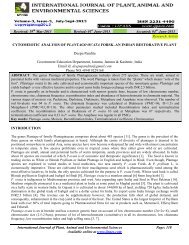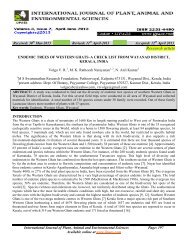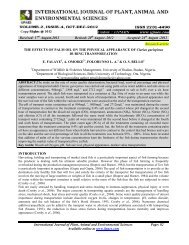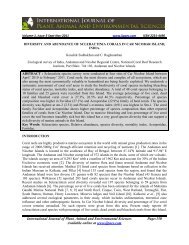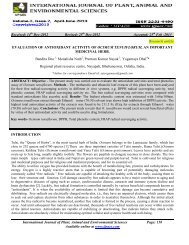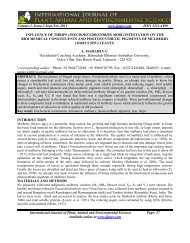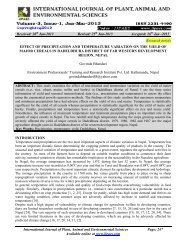biobleaching and delignification of hard wood kraft pulp ... - Ijpaes.com
biobleaching and delignification of hard wood kraft pulp ... - Ijpaes.com
biobleaching and delignification of hard wood kraft pulp ... - Ijpaes.com
Create successful ePaper yourself
Turn your PDF publications into a flip-book with our unique Google optimized e-Paper software.
Selvam <strong>and</strong> Arung<strong>and</strong>hi Copyrights@2013 IJPAES ISSN 2231-4490<br />
The bleaching agents used in <strong>pulp</strong> <strong>and</strong> paper industries are chlorine, alkali, hypochloride <strong>and</strong> hydrogen peroxide. The<br />
use <strong>of</strong> chlorine based chemicals in the bleaching process generates chlorophenol <strong>com</strong>pounds which are <strong>com</strong>pletely<br />
resistant to microbial attack <strong>and</strong> remain as recalcitrants [12].<br />
MATERIALS AND METHODS<br />
Collection <strong>of</strong> fungi<br />
The fungi Trametes sp., Ganoderma sp. <strong>and</strong> Poria sp. were collected from Western Ghats area <strong>of</strong> Tamilnadu <strong>and</strong><br />
Karnataka, India <strong>and</strong> were isolated from decayed <strong>wood</strong> <strong>of</strong> Tamarindus indica, Eucalyptus gr<strong>and</strong>is <strong>and</strong> Tectonia<br />
gr<strong>and</strong>is respectively. The collection sight was situated in the latitude <strong>of</strong> -11.58 ° S <strong>and</strong> longitude <strong>of</strong> 76.93 ° E at 400 ±<br />
50M MSL. It receives rain fall <strong>of</strong> about 300 mm per year with high humidity <strong>and</strong> temperature. The collected samples<br />
were used for further studies.<br />
Fungi isolation<br />
The portion <strong>of</strong> the fungi was cut, surface sterilized with 1 per cent mercuric chloride solution <strong>and</strong> then repeatedly<br />
washed with sterile distilled water [13]. The fungi were then inoculated on 2 per cent malt agar medium in petriplates.<br />
Then the fungal growth which occurred on the plates were sub cultured on malt agar slants to obtain pure culture. The<br />
samples were identified based on the morphology <strong>of</strong> the fruiting bodies <strong>and</strong> spores on the key provided previously<br />
[14, 15].<br />
Preparation <strong>of</strong> spore suspension<br />
The fungi were grown in malt agar medium by dissolving 20 g <strong>of</strong> malt extract in distilled water <strong>and</strong> made up to 1000<br />
ml. The pH was maintained as 6.5 at 37 ° C then the plates were flooded with sterile distilled water <strong>and</strong> brushed with<br />
camel hair brush smoothly without disturbing the mycelial growth <strong>and</strong> filtered through a sterile filter. The<br />
concentration <strong>of</strong> the filtrate was adjusted to 10 5 spores/ml <strong>and</strong> inoculum was used for further studies.<br />
Biobleaching <strong>and</strong> <strong>delignification</strong> <strong>of</strong> <strong>hard</strong> <strong>wood</strong> <strong>kraft</strong> <strong>pulp</strong> (HWKP)<br />
The HWKP <strong>of</strong> Eucalyptus gr<strong>and</strong>is was obtained from Tamil Nadu Newsprint <strong>and</strong> Paper industry limited karur, Tamil<br />
Nadu, India. Mycological broth (200 ml) in a conical flask (500 ml) added with a glass bead (2.5 cm dia) <strong>and</strong> HWKP<br />
(0.25%) was inoculated with fungal spore suspension (10 5 spores/ml) <strong>and</strong> incubated with shaking (200 rpm) at 25°C<br />
for 5 days. After 5 days, the resulting suspension was inoculated (15% v/v) into 500 ml flasks containing sterile water<br />
(200 ml) <strong>and</strong> 1 or 2 per cent HWKP (dry weight basis). The flasks were incubated with shaking (200 rpm) at 25°C for<br />
2 to 10 days [16].<br />
Mycological broth<br />
Bactosoytone - 10.0 g<br />
D Glucose - 40.0 g<br />
*Trace element solution - 1.0 ml<br />
Distilled water - 1000 ml<br />
pH adjusted to - 4.5 to 5.0<br />
*Trace element solution<br />
FeCl 3 - 27.03 mg<br />
Na 3 C 6 H 5 O 7 - 24.97 mg<br />
CuSO 4 - 1176.4 mg<br />
ZnCl 2 - 24.97 mg<br />
MnSO 4 - 476.10 mg<br />
MgCl 2 - 338.02 mg<br />
CoCl 2 - 118.97 mg<br />
NiCl 2 - 2.377 mg<br />
(NH 4 ) 6 Mo 7 O 24 - 61.80 mg<br />
Distilled water - 100 ml<br />
Parameters studied<br />
The final pH, kappa number <strong>and</strong> brightness <strong>of</strong> the treated <strong>pulp</strong> were determined. The pH <strong>of</strong> the <strong>pulp</strong> solution was<br />
measured directly by using a pH meter. Kappa number <strong>and</strong> brightness were estimated from st<strong>and</strong>ard h<strong>and</strong> sheets<br />
prepared from the <strong>pulp</strong> after harvest.<br />
International Journal <strong>of</strong> Plant, Animal <strong>and</strong> Environmental Sciences Page: 97<br />
Available online at www.ijpaes.<strong>com</strong>



